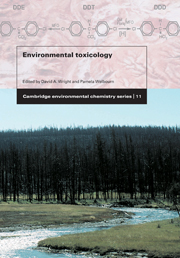Book contents
- Frontmatter
- Contents
- Foreword
- Preface
- Abbreviations
- Acknowledgements
- 1 The emergence of environmental toxicology as science
- 2 The science of environmental toxicology: Concepts and definitions
- 3 Routes and kinetics of toxicant uptake
- 4 Methodological approaches
- 5 Factors affecting toxicity
- 6 Metals and other inorganic chemicals
- 7 Organic compounds
- 8 Ionising radiation
- 9 Complex issues
- 10 Risk assessment
- 11 Recovery, rehabilitation, and reclamation
- 12 Regulatory toxicology
- 13 An overall perspective, or where to from here?
- Glossary
- Index
5 - Factors affecting toxicity
Published online by Cambridge University Press: 05 June 2012
- Frontmatter
- Contents
- Foreword
- Preface
- Abbreviations
- Acknowledgements
- 1 The emergence of environmental toxicology as science
- 2 The science of environmental toxicology: Concepts and definitions
- 3 Routes and kinetics of toxicant uptake
- 4 Methodological approaches
- 5 Factors affecting toxicity
- 6 Metals and other inorganic chemicals
- 7 Organic compounds
- 8 Ionising radiation
- 9 Complex issues
- 10 Risk assessment
- 11 Recovery, rehabilitation, and reclamation
- 12 Regulatory toxicology
- 13 An overall perspective, or where to from here?
- Glossary
- Index
Summary
Introduction
In Chapter 2, we saw that the exposure of organisms to toxic agents in the environment may result in adverse effects if the exposure concentration and time exceed certain thresholds. A primary goal of toxicologists is to establish a quantitative relationship between toxic exposure and degree of effect. Usually this takes the form of a dose-response curve, although in environmental toxicology we often use the concentration of the toxicant in the exposure medium as a substitute for dose. In doing so, we are assuming that the ambient toxicant concentration has a direct relationship to the dose accumulated by the organism, even though we may choose not to quantify the dose during a bioassay. Although such an assumption seems reasonable, a variety of extraneous factors, individually and collectively, may significantly affect this relationship by varying the bioavailability of a toxic chemical or by altering its metabolism.
Chemical bioavailability may be influenced by a number of abiotic parameters such as temperature and water chemistry, as well as a variety of biological factors relating to the physical condition of the organism. Morphological and biochemical differences between or among organisms of different size and/or taxonomic group may have an enormous influence on how they react to different types of toxic agents, and, as described in Chapter 4, prolonged exposure to sublethal toxicant concentrations may actually lead to changes in chemical tolerance. There are, then a multitude of factors that are likely to affect the expression of toxicity, either within, between, or among species.
- Type
- Chapter
- Information
- Environmental Toxicology , pp. 218 - 248Publisher: Cambridge University PressPrint publication year: 2002
- 3
- Cited by



